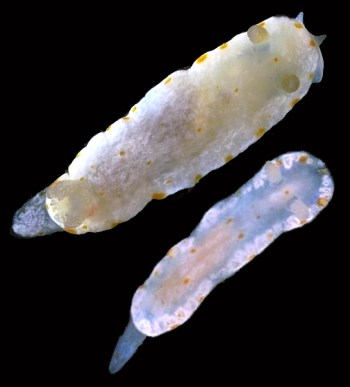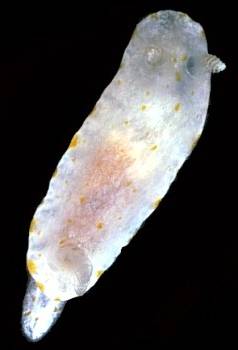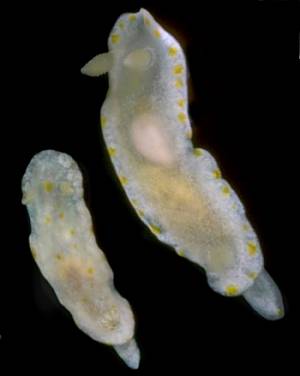
Noumea aureopunctata
Rudman, 1987
Order: NUDIBRANCHIA
Suborder: DORIDINA
Superfamily: EUDORIDOIDEA
Family: Chromodorididae
DISTRIBUTION
Known from Bass Strait [Tasmania, Victoria] Australia.
PHOTO
UPPER RIGHT: Showing adult (upper) and juvenile (lower) animals. Upper - Port Phillip Bay, Victoria, Australia. March 1986, AM C149514. Lower - Boat Harbour, N.W. Tasmania, 7mm long alive, 12m, 26 May 1985, AM C146609.
LOWER LEFT: West of Don River mouth, Devonport, Tasmania; l2 mm long alive, 7 m, 2l February l984, HOLOTYPE (AM Cl4l30l).
LOWER RIGHT: Comparing N. aureopunctata (left) and C. tasmaniensis (right). Horseshoe Reef, Devonport, Tasmania; 12 m, 3 February 1985. N. aureopunctata: AM C144705, 10 mm long alive. C. tasmaniensis: AM C144703, 12 mm long alive.
PHOTOS: Bill Rudman
The mantle is translucent with a dusting of opaque white aggregated into spots and blotches. At the edge of the mantle the dusting is fairly complete forming an irregular whitish band around the edge. Opaque white mantle glands around the edge accentuate the white margin. There are irregularly sized and shaped yellow spots right at the edge of the mantle and a few smaller ones scattered over the rest of the mantle. The stalk and the club of each rhinophore is translucent with the tip and upper two-thirds of the club dusted with white. In some specimens there is a yellow spot just below the tip of each rhinophore in the anterior midline. The gills are translucent with some white dusting and speckling. The sides of the body and foot are translucent with white blotches and on the posterior part of the foot there is an almost complete covering of white. There are scattered yellow spots on the sides of the body and sometimes there are a series of yellow spots forming a submarginal row around the edge of the foot. The mantle is ovate with a moderate mantle overlap which folds down to partially obscure the sides of the body. The subepithelial mantle glands form a submarginal band around the mantle and the simple gills form an upright circle around the anal papilla.
This species is very similar in colour to Chromodoris epicuria both species having a translucent mantle with whitish markings and yellow or orange spots. In C. epicuria the coloured spots around the edge of the mantle are submarginal whereas in Noumea aureopunctata they are marginal. Also in N. aureopunctata the white pigmentation is arranged as patches rather than lines and from the available specimens the spots are yellow not yellow-orange or orange as in C. epicuria. Some juvenile specimens of Chromodoris tasmaniensis are also identical in colour to N. aureopunctata, and in juvenile specimens of C. tasmaniensis with orange-yellow spots, there is no clear means of distinguishing the two on colour pattern alone.
References:
• Rudman, W.B. (1987) The Chromodorididae (Opisthobranchia : Mollusca) of the Indo-West Pacific: Chromodoris epicuria, C. aureopurpurea, C. annulata, C. coi and Risbecia tryoni colour groups. Zoological Journal of the Linnean Society, 90: 305-407.
• Rudman, W.B. (1991) Purpose in pattern: The evolution of colour in chromodorid nudibranchs. Journal of Molluscan Studies. 57 (T.E.Thompson Memorial Issue): 5-21.
PHOTOS:
LOWER LEFT: West of Don River mouth, Devonport, Tasmania; l2 mm long alive, 7 m, 2l February l984, HOLOTYPE (AM Cl4l30l).
LOWER RIGHT: Comparing N. aureopunctata (left) and C. tasmaniensis (right). Horseshoe Reef, Devonport, Tasmania; 12 m, 3 February 1985. N. aureopunctata: AM C144705, 10 mm long alive. C. tasmaniensis: AM C144703, 12 mm long alive.
PHOTOS: Bill Rudman


Rudman, W.B., 2002 (June 24) Noumea aureopunctata Rudman, 1987. [In] Sea Slug Forum. Australian Museum, Sydney. Available from http://www.seaslugforum.net/find/noumaure
Related messages
Noumea aureopunctata from southeastern Australia
June 26, 2002
From: Bill Rudman
To answer John Chuk's message I have prepared a page on the southeastern Australian endemic species Noumea aureopunctata. I probably promised to put this page up some months/ years ago - better late than never
Bill Rudman
